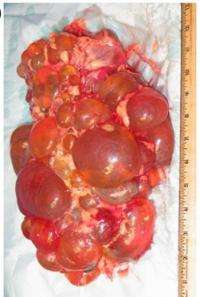Single gene controls development of many forms of polycystic disease

A single gene is central in the development of several forms of polycystic kidney and liver disease, Yale School of Medicine researchers report in the June 19 issue of Nature Genetics.
The findings suggest manipulating activity of PKD1, the gene causing the most common form of polycystic kidney disease, may prove beneficial in reducing cysts in both liver and kidney.
"We found that these conditions are not the result of an all or nothing phenomenon," said Stefan Somlo, the C.N.H. Long Professor of Medicine and Genetics and Chief, Section of Nephrology and senior author of the study. "The less PKD1 is expressed, the more cysts develop. Conversely, expressing more PKD1 can slow the process."
The most common form of this condition is called autosomal dominant polycystic kidney disease (ADPKD), a condition passed on to children from one parent affected with the disease that is found in 600,000 people in the United States alone. Two genes, PKD1 and PKD2, are responsible for the onset of this condition.
PKD patients also develop cysts of the liver and Somlo and colleagues had previously identified families with identical cysts found only in the liver. They found two different genes were responsible for this related condition.
The researchers wanted to know how liver-only polycystic disease was related to ADPKD. In a series of experiments using both genetically engineered mouse models and biochemical studies, they found that the activity of only one of the four genes, PKD1, controlled cyst formation in the other forms of the disease. Experiments in mice showed that modulating dosage of PKD1 could slow disease progression.
"The data suggest the exciting possibility that targeting the activity of PKD1 may be beneficial for treatment of isolated polycystic liver disease, childhood recessive polycystic kidney disease and even a subset of adult ADPKD," said Somlo.
Yale is a leader in the investigation of PKD. For instance basic scientific research conducted at Yale has been crucial in helping to identify cilia, the tiny thread-like structure that extends from a cell's surface, as a critical component in cyst forming pathways. Yale has been the home of one of the four NIH-funded national centers of excellence in PKD research since 1999. In addition, the laboratory of Craig Crews, Lewis B. Cullman Professor of Molecular, Cellular, and Developmental Biology and Professor of Chemistry and of Pharmacology, has identified a compound that has shown promise in reducing number of cysts in some mouse models of PKD.
















